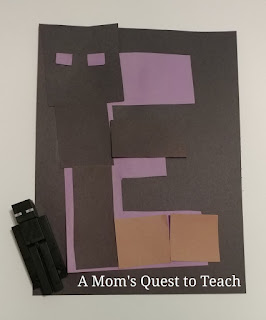This post contains affiliate
links. For more information, please see my Terms of Use and Disclosure Policy
page. Thank you.
For the letter E, we focused upon Elephant.
Elephants are known as the largest land mammal. There are two different types - African Elephants and Asiatic Elephants. As mammals, they give birth to live young (called calves), produce milk for their young, have fine, coarse hair on their bodies, and are warm-blooded (their body temperature is regulated internally).
 |
| Female African Elephant on left; Female Asiatic Elephant on right |
African Elephant Characteristics
Asiatic Elephant Characteristics
Male elephants are called bulls while female elephants are known as cows and young elephants are called calves. An elephant calf is no small baby – it can be 3 feet tall at birth and weigh 200 pounds. Compare that to the size and weight of your children so they can see the difference.
Tusks are actually teeth that grow very large. An elephant will go through six sets of teeth in its mouth over the course of its lifespan. Each set of teeth is worn down by the food the elephant eats and each set usually lasts about 10 years. So, an average elephant usually lives about 60 years because it will not be able to chew food after its last set of teeth get worn down.
The large ears of an elephant help keep the elephant cool by acting as more than just a fan. When they flap their ears, the blood flowing through their ears is actually cooled and carried through the rest of the body – thus cooling the entire elephant.
- Large ears (they are almost shaped like the continent of Africa)
- Both male and female African elephants have tusks
- Larger than Asiatic elephants
- Males are approximately 10 feet tall & weigh over 12,000 pounds
Asiatic Elephant Characteristics
- Smaller ears than African elephants
- High foreheads with two large bumps
- Usually only male Asiatic elephants have tusks
- Males are approximately 9 feet tall & weight about 10,000 pounds
Male elephants are called bulls while female elephants are known as cows and young elephants are called calves. An elephant calf is no small baby – it can be 3 feet tall at birth and weigh 200 pounds. Compare that to the size and weight of your children so they can see the difference.
 |
Tusks are actually teeth that grow very large. An elephant will go through six sets of teeth in its mouth over the course of its lifespan. Each set of teeth is worn down by the food the elephant eats and each set usually lasts about 10 years. So, an average elephant usually lives about 60 years because it will not be able to chew food after its last set of teeth get worn down.
The large ears of an elephant help keep the elephant cool by acting as more than just a fan. When they flap their ears, the blood flowing through their ears is actually cooled and carried through the rest of the body – thus cooling the entire elephant.
Coloring Sheets
Coloring.WS from DLTK's Elephant Coloring Pages
There are a variety of realistic and cartoon elephant pictures for your children to color.
Super Coloring's Elephants Coloring Pages
There is a selection of cartoon and realistic pictures available to print and color.
Easy Peasy and Fun's Free Elephant Coloring Pages for Adults
If you are interested in joining in on the coloring fun, check out these abstract elephant coloring pages!
Projects
This great craft from Look! We're Learning only requires five materials to create your own elephant to decorate your home.
These are adorable elephants made using recycled plastic milk containers. With as much milk as we go through in our house, we could make a whole herd of elephants!
Gather together socks, polyfil, rubberbands, rice or beans, googly eyes, and felt and make your own plush elephant with your children - no needles needed!
Books
Whether you are looking for fictional or factual books about elephants, they are such an interesting animal to read about with your children.
Featured Shape
This week take a look at circles and spheres. On a globe or a map of the world, help your children circle where African Elephants and Asian Elephants live in the wild.
Cut out different sizes of circles and have your children sort them into different piles based on their size - from smallest to largest. Remind them that the largest land mammal, the elephant, started out smaller when they were babies.
Activities
Sorting Big Es and Little Es
Cut out a variety of upper and lower case Es and es for your children to sort. Since this week we are talking about elephants, which are rather large, it is perfect to draw the parallels between large letters (uppercase) and small letters (lowercase).
Other Topics
Do you have a Minecraft fan in the house? Try this Letter E craft that features an Enderman.
Eggs
There are so many different activities you can do with eggs. Here are a few ideas.
Made with Happy's Plastic Easter Egg Flower Pots
123 Homeschool 4 Me Collection of 14 Amazing Egg Science Experiments
Resources
No Time for Flash Cards' Letter of the Week - Letter E Theme
World Wildlife Fund's Elephant Page
National Geographic's African Elephant Page
I linked up to the following blog(s):









Kids of all ages love elephants, don't they!? These are great ideas for teaching little ones. :-)
ReplyDeleteThank you!
DeleteWhat a great post full of elephant ideas! Our girls' favorite elephant book was always Elmer
ReplyDeleteThank you! My favorite when growing up was Babar. I even had a little plush of him.
Deletethose sock elephants are WAY TOO CUTE!!!! Did you make any?
ReplyDeleteNo...we ran out of time this week. So many cool things to do with kids - not enough time.
Delete